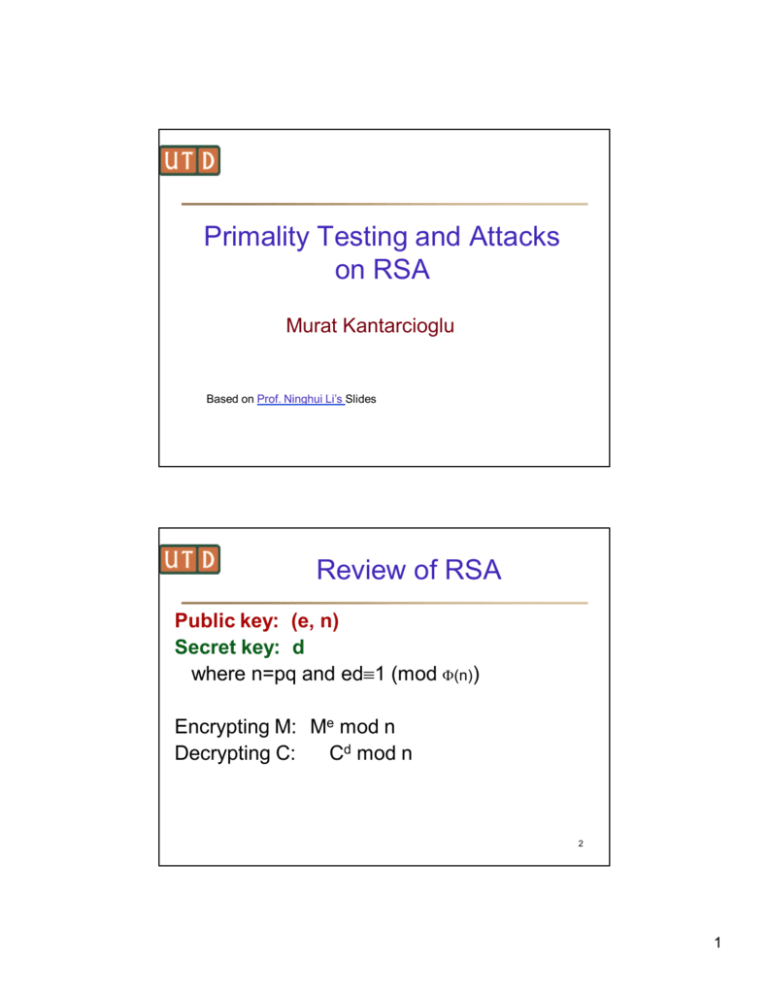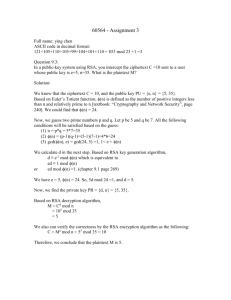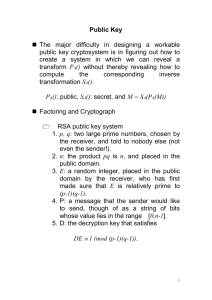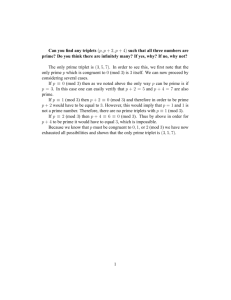Slides
advertisement

Primality Testing and Attacks
on RSA
Murat Kantarcioglu
Based on Prof. Ninghui Li’s Slides
Review of RSA
Public key: (e, n)
Secret key: d
where n=pq and ed≡1 (mod Φ(n))
Encrypting M: Me mod n
Decrypting C:
Cd mod n
2
1
Lecture Outline
•
•
•
•
•
•
Number of prime numbers
Cyclic groups
Quadratic residues
Primality testing
Factorization
Attacks on RSA
3
Number of Prime Numbers
Theorem
The number of prime numbers is infinite.
Proof: For the sake of contradiction, assume that the
number of prime numbers is finite. Let p1, p2, … pk be
all primes. Let n = p1 p2 … pk+1, then n must be
composite.
Then there exists a prime p s.t. p | n (fundamental
theorem of arithmetic), and p cannot be any of the p1,
p2, … pk. (Why?)
Therefore, p1, … pk were not all the prime numbers.
4
2
Distribution of Prime Numbers
Theorem (Gaps between primes)
For every positive integer n, there are n or
more consecutive composite numbers.
Proof Idea:
The consective numbers
(n+1)! + 2, (n+1)! + 3, …., (n+1)! + n+1
are composite.
(Why?)
5
Distribution of Prime Numbers
Definition
Given real number x, let π(x) be the
number of prime numbers x.
Theorem (prime numbers theorem)
π (x)
lim
x →∞
x /ln x
=1
For a very large number x, the number of
prime numbers smaller than x is close to
x/ln x.
6
3
Generating large prime
numbers
• Randomly generate a large odd number and then test
whether it is prime.
• How many random integers need to be tested before
finding a prime?
– the number of prime numbers ≤ p is about p/ ln p
– roughly every ln p integers has a prime
• for a 512 bit p, ln p = 355. on average, need to
test about 177=355/2 odd numbers
• Need to solve the Primality testing problem
– the decision problem to decide whether a number is a
prime
7
{Complexity}
Complexity theory: mathematical discipline that
classifies problems based on the difficulty to solve
them.
P-class (polynomial-time): number of steps
needed to solve a problem is bounded by some
power of the problem's size.
NP-class (nondeterministic polynomial-time): it
permits a nondeterministic solution and the
number of steps to verify the solution is bounded
by some power of the problem's size.
8
4
Testing for Primality
Theorem
Composite numbers have a divisor less than equal to their square
root.
Proof idea:
n composite, so n = ab, 0 < a b < n, then a
we obtain ab > n (contradiction).
sqrt(n), otherwise
Algorithm 1
for (i=2, i < sqrt(n) + 1); i++) {
If i a divisor of n {
n is composite
}
}
n is prime
Running time is O(sqrt(n)), which is exponential in the size of the
binary representation of n
9
More Efficient Algorithms for
Primality Testing
Primality testing is easier than prime
factorization, and is in P-class.
How can we tell if a number is prime or not
without factoring the number?
• The most efficient algorithms are randomized.
• Solovay-Strassen
• Rabin-Miler
10
5
Groups
• A group donated by (G,*) is a set of non-empty elements
with binary operation *
• Closure: a*b ∈ G for all a,b ∈ G
• Associativity: (a*b)*c=a*(b*c) for all a,b,c ∈ G
• Identity Element: There exists unique e s.t. e*a=a*e=a for
all a ∈ G
• Inverse: Every element a ∈ G has an inverse b s.t.
a*b=b*a=e
• Commutativity: a*b=b*a for all a,b ∈ G
More Number Theory First
• Definition: Given a group (G,•),
– the order of G is |G|
– the order of an element a in G is the smallest
positive integer such that am=1
– {a,a2,…,am} is a subgroup of G
• (why?)
• Definition: a group (G,•) is a cyclic group if there exists
g∈G such that G={g, g•g, g3, …, g|G|}
– g is known as a generator
– the order of g is |G|
• (why?)
12
6
Zp* is a Cyclic Group
• Fact: Given a prime p, Zp* is a cyclic group.
– we won’t prove it here.
• There exists g∈ Zp* s.t. {gj | 1≤j ≤p-1} = Zp*
– g is a generator of Zp*,
– g is also known as the primitive element modulo p
– what is the order of g
• For example, 2 is a generator for Z11*
– {2j | 1≤ j ≤p-1} = {2,4,8,5,10,9,7,3,6,1}
– what is the order of 4=22? what is the order of 8=23?
• Let g be a generator of Zp*, and let a=gj
– the order of a is (p-1)/gcd(p-1,j)
– what are the primitive elements in Z11*?
13
Testing Primitive Elements
Modulo p
• The number of primitive elements modulo
p is φ(p-1).
Theorem: Let p be a prime, a∈Zp* is a
primitive element modulo p iff. a(p-1)/q ≠1
(mod p) for all primes q such that q|(p-1).
Proof. The only if direction is straightforward.
For the if direction. If a is not primitive, it has order d<(p-1).
Then d is a divisor of (p-1). Let q be a prime factor of (p1)/d, i.e., (p-1)/d=cq. Then (p-1)/q=cd. Then a(p-1)/q =1
(mod p).
14
7
Quadratic Residues Modulo A
Prime
Definition
• a is a quadratic residue modulo p if ∃ b ∈Zp* such
that b2 ≡ a mod p,
• otherwise when a≠0, a is a quadratic nonresidue
• Qp is the set of all quadratic residues
•
Q p is the set of all quadratic nonresidues
• If p is prime there are (p-1)/2 quadratic residues in Zp*,
|Qp| = (p-1)/2
– let g be generator of Zp*, then a=gj is a quadratic residue iff. j
is even.
15
How Many Square Roots Does
an Element in Qp has
• A element a in Qp has exactly two square
roots
– a has at least two square roots
• if b2 ≡ a mod p, then (p-b)2 ≡ a mod p
– a has at most two square roots in Zp*
• if b2 ≡ a mod p and c2 ≡ a mod p, then b2 –c2 ≡ 0
mod p
• then p | (b+c)(b-c), either b=c, or b+c=p
16
8
Legendre Symbol
• Let p be an odd prime and a an
integer. The Legendre symbol is
defined
0, if p | a
a
= 1, if a ∈ Qp
p
−1, if a ∈ Qp
17
Euler’s Criterion
Theorem: If a (p-1)/2 ≡ 1 mod p, then a is a quadratic
residue ( if ≡ -1 then a is a quadratic nonresidue)
I.e., the Legendre symbol
a
p
=a
(p-1)/2
mod p
Proof. If a = y2, then a (p-1)/2 = y(p-1) = 1 (mod p)
If a (p-1)/2=1, let a = gj, where g is a generator of the
group Zp*. Then gj (p-1)/2 = 1 (mod p). Since g is a
generator, (p-1) | j (p-1)/2, thus j must be even.
Therefore, a=gj is QR.
18
9
Jacobi Symbol
• let n ≥ 3 be odd with prime factorization
n = p1e1 p2e2 ... pkek
• the Jacobi symbol is defined to be
a
a
=
n
p1
e1
a
p2
e2
a
...
pk
ek
• the Jacobi symbol can be computed without
factoring n (see the textbook for details)
19
Euler Pseudo-prime
• For any prime p, the Legendre symbol
a
p
= a(p-1)/2 mod p
a
• For a composite n, if the Jacobi symbol n = a(n-1)/2 mod n
then n is called an Euler pseudo-prime to the base a,
– i.e., a is a “pseudo” evidence that n is prime
• For any composite n, the number of “pseudo” evidences
that n is prime for at most half of the integers in Zn*
20
10
Randomized Algorithms
• A yes-biased Monte Carlo algorithm is a randomized
algorithm for a decision problem in which a “yes” answer
is (always correct), but a “no” answer may be incorrect
– error probability for an instance is the probability that instance is
answered incorrectly
– error probability for the algorithm is the max among all instance
error probabilities
• A no-biased Monte Carlo algorithm is defined similarly
• A Las Vegas algorithm may not give an answer, but any
answer it gives is correct
21
The Solovay-Strassen Algorithm
Solovay-Strassen(n)
choose a random integer a s.t. 1≤a≤n-1
a
x← n
if x=0 then return (“n is composite”)
// gcd(x,n)≠1
(n-1)/2
y←a
mod n
if (x=y) then return (“n is prime”)
// either n is a prime, or a pseudo-prime
else return (“n is composite”)
// violates Euler’s criterion
If n is composite, it passes the test with at most ½ prob.
Use multiple tests before accepting n as prime.
22
11
Rabin-Miller Test
• Another efficient probabilistic algorithm for determining if a
given number n is prime.
– Write n-1 as 2km, with m odd.
– Choose a random integer a, 1 a n-1.
– b ← am mod n
– if b=1 then return “n is prime”
– compute b, b2,b4,…,b2^(k-1), if we find -1, return “n is
prime”
– return “n is composite”
• A composite number pass the test with ¼ prob.
• When t tests are used with independent a, a composite
passes with (¼)t prob.
• The test is fast, used very often in practice.
23
Why Rabin-Miller Test Work
Claim: If the algorithm returns “n is composite”, then n is not
a prime.
Proof: if we choose a and returns composite on n, then
– am≠1, am≠-1, a2m ≠ -1, a4m ≠ -1, …, a2^{k-1}m ≠ -1 (mod n
)
– suppose, for the sake of contradiction, that n is prime,
– then an-1=a2^{k}m=1 (mod n)
– then there are two square roots modulo n, 1 and -1
– then a2^{k-1}m = a2^{k-2}m = a2m = am = 1 (contradiction!)
– so if n is prime, the algorithm will not return
“composite”
24
12
Quadratic Residues Modulo a
Composite
Definition: a is a quadratic residue modulo n (a∈Qn) if ∃ b
∈Zn* such that b2 ≡ a mod n, otherwise when a≠0, a is a
quadratic nonresidue
Fact: a∈Qn*, where n=pq, iff. a∈Qp and a∈Qq
• If b2 ≡ a mod n, then b2 ≡ a mod p and b2 ≡ a mod q
• If b2 ≡ a mod p and c2 ≡ a mod q, then the solutions to
x ≡ b mod p and x ≡ c mod q
x ≡ b mod p and x ≡ -c mod q
x ≡ -b mod p and x ≡ c mod q
x ≡ -b mod p and x ≡ -c mod q
satisfies x2 ≡ a mod n
25
Quadratic Residues Modulo a
Composite
• |Qn| = |Qp| • |Qq| = (p-1)(q-1)/4
• Q n = 3(p-1)(q-1)/4
• Jacobi symbol does not tell whether a number a is a QR
a
a
=
n
p
•
•
•
•
a
q
when it is -1, then either a∈Qp ∧ a∉Qq or a∉Qp ∧ a∈Qq
when it is 1, then either a∈Qp ∧ a∈Qq or a∉Qp ∧ a∉Qq
it is widely believed that determining QR modulo n given
a
= 1 is equivalent to factoring n, no proof is
that
n
known
– without factoring, one can guess correctly with prob. ½
26
13
Summary of Number Theory
Results Covered
• Zp* is a cyclic group
– has generators
• QR and QNR in Zp* can be easily determined by
computing the Legendre symbol
• Jacobi symbol (generalizes Legendre symbol to
composites)
– can be computed without factoring n
– Jacobi symbol does not determine QR in Zn*
– QR in Zn* is hard
• Primality Testing
– Solovay-Strassen
– Rabin-Miller
27
Brief Overview of Attacks on
RSA
• Goals:
– recover secret key d
• Brute force key search
– infeasible
• Timing attacks
• Mathematical attacks
– decrypt one message
– learn information from the cipher texts
28
14
Timing Attacks
• Timing Attacks on Implementations of DiffieHellman, RSA, DSS, and Other Systems (1996),
Paul C. Kocher
• By measuring the time required to perform
decryption (exponentiation with the private key as
exponent), an attacker can figure out the private
key
• Possible countermeasures:
– use constant exponentiation time
– add random delays
– blind values used in calculations
29
Timing Attacks (cont.)
• Is it possible in practice? YES.
OpenSSL Security Advisory [17 March 2003]
Timing-based attacks on RSA keys
================================
OpenSSL v0.9.7a and 0.9.6i vulnerability
---------------------------------------Researchers have discovered a timing attack on RSA keys, to
which OpenSSL is generally vulnerable, unless RSA blinding has
been turned on.
30
15
Math-Based Key Recovery
Attacks
•
Three possible approaches:
1. Factor n = pq
2. Determine Φ(n)
3. Find the private key d
directly
•
All the above are equivalent
to factoring n
–
–
–
1 implies 2
2 implies 3
needs to show that 3 implies 1
31
Φ(n) implies factorization
• Knowing both n and Φ(n), one knows
n = pq
Φ(n) = (p-1)(q-1) = pq – p – q + 1
= n – p – n/p + 1
pΦ(n) = np – p2 – n + p
p2 – np + Φ(n)p – p + n = 0
p2 – (n – Φ(n) + 1) p + n = 0
• There are two solutions of p in the above equation.
• Both p and q are solutions.
32
16
Factoring Large Numbers
• Three most effective algorithms are
– quadratic sieve
– elliptic curve factoring algorithm
– number field sieve
• One idea many factoring algorithms use:
– Suppose one find x2≡y2 (mod n) such that x≠y
(mod n) and x≠-y (mod n). Then n | (xy)(x+y). Neither (x-y) or (x+y) is divisible by n;
thus, gcd(x-y,n) has a non-trivial factor of n
33
Time complexity of factoring
• quadratic sieve:
– O(e(1+o(1))sqrt(ln n ln ln n))
for n around 21024, O(e68)
• elliptic curve factoring algorithm
– O(e(1+o(1))sqrt(2 ln p ln ln p)), where p is the smallest prime factor
– for n=pq and p,q around 2512,
for n around 21024 O (e65)
• number field sieve
– O(e(1.92+o(1)) (ln n)^1/3 (ln ln n)^2/3),
for n around 21024 O (e60)
• Multiple 512-bit moduli have been factored
• Extrapolating trends of factoring suggests that
– 768-bit moduli will be factored by 2010
– 1024-bit moduli will be factored by 2018
34
17
Factoring when knowing e
and d
• Fact: if n=pq, then x2≡1 (mod n) has four solutions that
are <n.
– x2≡1 (mod n) if and only if
both x2≡1 (mod p) and x2≡1 (mod q)
– Two trivial solutions: 1 and n-1
• 1 is solution to x ≡ 1 (mod p) and x ≡ 1 (mod q)
• n-1 is solution to x ≡ -1 (mod p) and x ≡ -1 (mod q)
– Two other solutions
• solution to x ≡ 1 (mod p) and x ≡ -1 (mod q)
• solution to x ≡ -1 (mod p) and x ≡ 1 (mod q)
– E.g., n=3 5=15, then x2≡1 (mod 15) has the following solutions:
1, 4, 11, 14
35
Factoring when knowing e
and d
• Knowing a nontrivial solution to x2≡1 (mod
n)
– compute gcd(x+1,n) and gcd(x-1,n)
• E.g., 4 and 11 are solution to x2≡1 (mod
15)
– gcd(4+1,15) = 5
– gcd(4-1,15) = 3
– gcd(11+1,15) = 3
– gcd(11-1, 15) = 5
36
18
Factoring when knowing e
and d
• Knowing ed such that ed ≡ 1 (mod Φ(n))
write ed – 1 = 2s r (r odd)
choose w at random such that 1<w<n-1
if w not relative prime to n then return gcd(w,n)
(if gcd(w,n)=1, what value is (w2^s r mod n)?)
compute wr, w2r, w4r, …, by successive
squaring until find w2^t r ≡ 1 (mod n)
Fails when wr≡ 1 (mod n) or w2^t r≡ -1 (mod n)
Failure probability is less than ½ (Proof is complicated)
37
Summary of Key Recovery
Math-based Attacks on RSA
• Three possible approaches:
1.Factor n = pq
2.Determine Φ(n)
3.Find the private key d directly
• All are equivalent
– finding out d implies factoring n
– if factoring is hard, so is finding out d
• Should never have different users share one common
modulus
– (why?)
38
19
Decryption attacks on RSA
• The RSA Problem: Given a positive integer n that is a
product of two distinct large primes p and q, a positive
integer e such that gcd(e, (p-1)(q-1))=1, and an integer c,
find an integer m such that me≡c (mod n)
– widely believed that the RSA problem is
computationally equivalent to integer factorization;
however, no proof is known
• The security of RSA encryption’s scheme depends on the
hardness of the RSA problem.
39
20









